It has been about a week since my posts about online teaching and teaching online: Part One: “Managing Expectations,” Part Two: “Low Tech is the Best Tech,” and Part Three: “Wrangling Content.” Thanks to everyone who have shared them, chatted with me about them, used them, and liked them.
For this bonus post, I wanted to share some more of my own designs, hacks, choices, and materials as a way for people to see what one class might look like. The most recent online course I taught is my ENG 3060J: Women and Writing course, which is a junior composition/writing-heavy class, themed as “Critical Approaches to Buffy the Vampire Slayer” (Spring 2018). It is a class that I have taught as online-only multiple times at different institutions; it is perhaps my most refined online course. I have also taught a graduate course called ENG 7800, a special topics theory course, on “Keywords for Video Game Studies” (Spring 2018). For this post, I will mainly focus on ENG 3060J; you can see the full syllabus here.

Establish (Digital) Outcomes
Here is a part of the course description, including outcomes (which are in part based on the Junior Composition outcomes), which help manage the expectations of the online component of the class:
A REQUIREMENT for this class is a well-developed curiosity and a willingness to explore and interrogate interdisciplinary lines of inquiry. Our class will be organized around a survey of texts engaging scholarship, media, and popular culture. This class will take up everyday culture as critical practice, explore what it means to close read and think critically, and how popular culture can be deployed as theory, as dramatizing the concerns, wonders, struggles, and politics of lived life and experience.
THIS ONLINE COURSE will engage in watching, close reading, guided discussion, and some researching and analytical writing about how and what these texts argue, reveal, narrate, hide, perpetuate, and complicate the world we live in. You will be required to screen select Buffy episodes (and perhaps other things from the Whedon universe) as the focus of discussion and academic critique. Discussions, papers, and other assignments will be held online via the course website and Blackboard portal.
SPECIFICALLY, our course goals include (the formal junior composition outcomes are in bold, see the course Blackboard for a full listing of the outcomes):
• We will write for specific purposes, audiences and situations. To that end, we will develop and demonstrate a familiarity with a range of texts, terms, and theories of the study of Buffy, television, and popular culture.
• We will read a variety of texts and genres. We will identify and articulate different ways to explore, close read, analyze, and critique literature, film, television, and popular culture.
• We will research a variety of academic databases using appropriate and effective strategies. We will explore of a range of research tools and resources, and we will find and evaluate sources appropriate to our reading, writing, and study.
• We will consider questions and intersections of race, gender, sexuality, ability, class, nation, culture, and power.
• We will use science fiction and popular culture as vernacular theory to think, talk, write, and interrogate the world around us.
Drawing on the suggestions of fellow teachers, in the future, I am going to as specific outcome addressing online learning. Something like:
• We will develop skills and proficiencies for online learning, presentation, and collaboration. We will develop and demonstrate a familiarity with the course learning management system (LMS), using a range of digital tools and platforms, and managing online assignments, peer review, and discussion.
Online Participation
Building on my syllabus blurb on Guidelines for Online Discussion, I also reinforce the norms and expectations for how the course will run, how much time things might take, and how students should (re)frame their engagement with daily, weekly, and term-long activities and tasks. Messaging might include an adapted paragraph on what substantive participation looks like:
Participation and Preparedness (30%)
Preparedness and participation forms a large component of your final grade. It is essential that you prepare for class and regularly participate online. Moreover, negative participation will hurt your participation grade. Participation is determined by 1) your respectful presence in the class forums and interactions with me and others, 2) your willingness to discuss, comment, and ask questions, 3) your preparation for class, which includes having the required materials on hand and doing all of the assigned reading and watching for class, 4) your engagement in collaboration, group work, peer review, and presentations, and 5) your care and daily use of the class Blackboard–henceforth called the “class blog”–bookmark the address, check and comment regularly.
Online Netiquette
Related to the definition of participation, in the first days of the course, I make sure students read and acknowledge the “ground rules” and online etiquette for the LMS and other online tools. Much of this is common sense, but I think it is important to remind students (and hold them accountable) that like a F2F classroom, the “space” of the course is (semi-) formal, professional, shared, and collaborative. Most instructors have lamented that students send awkward, terse, sometimes too familiar emails as if they were talking to or texting their friends; sometimes students misunderstand or ignore the discursive and rhetorical contexts of the class and the learning management system treating the LMS like social media or customer service. Granted, there are wonderful opportunities to invite, talk about, and intermingle code switching and developing digital vocabularies and shorthand. As I wrote in my post on “Wrangling Content,” I tend to be more directive and more specific in the requirements and expectations for activities and assignments. Here is the post on “Discussion & Blog Etiquette and Netiquette,” which is a week one thread, which asks students to quickly reply that they have (at least) read it:
Before we get underway with the “blog”, I thought I’d point out a few dos and donts just to keep everyone on the same page. Please read carefully and post any comments, questions, or concerns you have about using the class message board.
The Rules of Engagement
Do participate.
Do post topics relevant to the class, to class discussions, to the assignments.
Do comment thoughtfully to posts.
Do ask questions about class, assignments, problems, details.
Do think before you write.
Do consider ideas in a deep way.
Do practice responsibility, accountability, and a certain amount of scholarliness.
Do react, respond, and reply.
Do consider other people’s feelings, points of view, and differences.
Do sign your name to your posts.
Do use punctuation.
Do use complete sentences or thoughts.
Do consider your audience and realize that your classmates may have expectations different from yours.
Do remember the blog is a public forum.
Do treat the blog with the same respect, honesty, generosity, and efficacy as you would treat me, the classroom, and your classmates.
Don’t be afraid to state your opinion, but don’t make claims without reasoning, critical thinking, and support.
Don’t be silent.
Don’t dismiss without at least consideration.
Don’t be afraid to post.
Don’t abuse your rights to authorship.
Don’t hate, don’t spam, don’t flame, don’t bully, don’t despair.
Keep the Following in Mind
The blog IS an extension of the classroom; the rhetorical, cultural, and social context should dictate what you say, how you say it, and why you say it; do participate and enjoy the process and the experience, but don’t do anything you would not do in person, in class.
Take ownership and responsibility for your words and actions online be it on the blog or in an email or IM; everyone should login or sign their comments with at least their first name and last initial.
Be encouraging and supportive of one another; the blog is a community and more importantly it is a safe space; everyone should feel like they have a voice, an opportunity to share, and a stake in the class and the blog.
Stay on topic, be relevant to the class; REPLY to the appropriate message/subject/contributor; try to include the name of the person you are replying to as well (e.g. “Ed, I saw your message and thought I’d answer…”).
Remember that participation on the blog is part of your overall class participation grade; negative participation will negatively affect your grade and will not be tolerated and may result in the revocation of posting rights (which in turn will hurt your participation).
Finally, don’t forget to keep up with the current posts and the comments to previous posts.
Please acknowledge that you have read these dos and donts by responding to the post (i.e. “I have read and understood the post!”).
Virtual Office Hours
As I said before, one of the places I offer synchronous interaction is through virtual office hours. Students have found this time to be extremely useful and helpful, particularly in establishing some semblance of rapport and cyberpresence. Again, I encourage instructors to require students to say hello at least once early on in the term to not only work out the technical details but also to demonstrate to students that you are available. (Granted, clear boundaries are needed lest you spend most of your time feeling like an IT help desk; direct students to the university’s IT department when necessary–that is what they are for.) Like face-to-face office hours and appointments, I have set times at least twice a week–once during the week and once over the weekend–and allow students to make schedule sessions if they are not able to make the usual hours. I also count using office hours toward their overall participation. Here is my syllabus blurb on my role and duties for “Online Instruction and Finding Help”:
My role in the course, as with any course, is to frame the goals and intellectual conversations of the class, to scaffold readings, assignments, and other tasks, to mentor and moderate projects and discussions, and to assess and grade your work. Given the online nature of the class, I will do my best to engage each and every one of you and the class as a whole in the following ways:
• Short videos or “lecturettes,” which first let you see a real “live” person who is professing as professor to the class, and second, are meant to be explanatory, clarifying, and hopefully, interesting.
• Curating blogging points, assignment Q&A, and other discussions, which will complement and supplement your posts and responses.
• Providing regular check-ins via email, blog posts, and online conferences. I will be available electronically by email, course blog, and virtual office hours. Email and the blog are the best means of contacting me. I will do my best to answer your emails and blog posts, usually within twenty-four hours.
• Holding virtual office hours via Google chat (or some other tool) twice a week; virtual office hours are posted in the sidebar. Please note that group chat is public to the entire class and allows for group discussions. If you would like to converse with me individually, you can use Google Hangouts. If you are not able to attend virtual office hours, email me your availability to set up an appointment, and I will do my best to accommodate your schedule. Otherwise, if you see that I am logged in to chat, during reasonable hours, you are more than welcome to discuss the class or ask questions. Please, when you initiate an IM conversation for the first time, please identify yourself to me; also, be patient because my responses may not be immediate.
Navigation
Below is a screen grab of my ENG 3060J’s Blackboard site to show how to think about site navigation (the lefthand column) and course organization (in this case in terms of weeks). I have renamed the course navigation links to be as simple and self-explanatory as possible and limited the number of possible choices by removing any item or tool not used by the class:
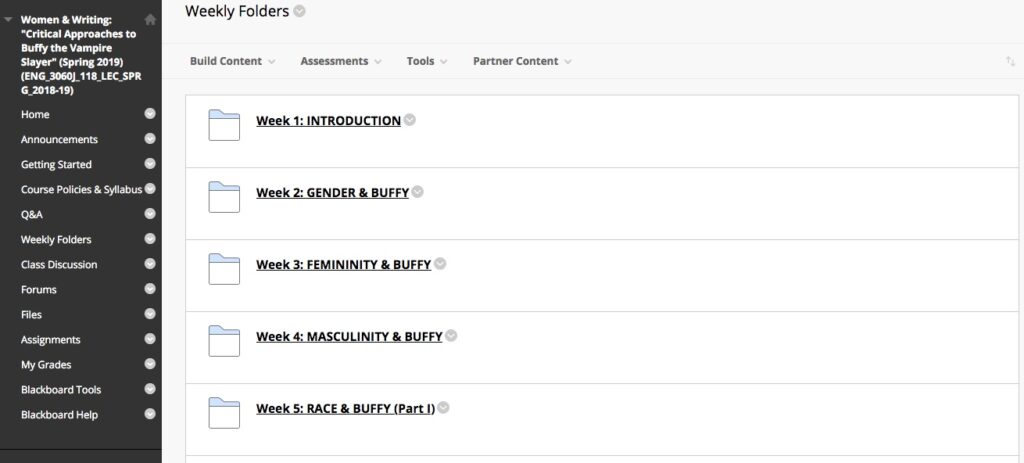
- HOME: Main page of the course LMS, which shows the default Blackboard suite of information.
- ANNOUNCEMENTS: Archive of weekly announcements (a feature of Blackboard, posted and sent out as emails). I send an Weekly Reminder announcement at the start of each week (in both on- and off-line classes) that sets up the week, includes what needs to be read or done, framing questions for the texts (i.e. what to look for or think about as they read or watch), and any housekeeping things (again with embedded links to the pertinent posts on the LMS).
- GETTING STARTED: An introductory page welcomes and orients students to the course, runs through quick details like required texts, and then asks them to do initial tasks like set up their LMS profile, complete certain tasks such as reading and responding to the Netiquette post or making sure they have a Google account needed for virtual office hours and peer review, and any startup information.
- COURSE POLICIES & SYLLABUS: A page that duplicates the paper or PDF version of the syllabus–again having information in multiple places and formats is helpful.
- Q&A: The forum for questions, comments, and concerns about logistics and how the class runs in general. This is so the threads about technology or assignments do not clutter up the class discussion area and group the nuts and bolts threads in an easily findable location.
- WEEKLY FOLDERS: Links to each week’s folder. See a typical week below.
- CLASS DISCUSSION: The forum for all lecture, discussion, and student-generated threads. Then links to particular or relevant posts are included in their respective weeks.
- FORUMS: Not fully needed but it shows students the different areas of posts or discussion. It offers another path to get to content. Moreover, sometimes I have forums that do not need to be immediately or regularly visible because they are for particular purposes.
- FILES: Where all PDFs and other documents, media, and such are housed. Again, organized alphabetically. Then links to particular docs are also included in their respective weeks.
- ASSIGNMENTS, MY GRADES, BLACKBOARD TOOLS & HELP: Standard Blackboard areas where students can see tasks, due dates, assessment, and get online help (alas Blackboard’s help is not particularly great).
A Typical Week
Below is an example of a typical week in my ENG 3060J courses–this is week one. As you can see, I try to put at the top all of the setup for the week, including reminders and links to readings, important threads, and an overview. The week, which is itself a folder, functions like a table of contents with links to each item, thread, file, assignment; nothing (save for the overview note) is native to the folder itself, which means students can find it in several places. For example, a reading is linked in the folder to the document in the Files are of the LMS so it can be found in at least two places. Or, for example, discussion posts are linked to the post that is in the forum called Class Discussion (where all threads are housed) so it, too, can be found in multiple locations. The week is organized roughly chronologically with early week material at the top, later week material towards the end. Some threads are released over time rather than all at once in part to encourage and maintain a pacing and rhythm to the class. Given that students will likely complete posts, responses, activities, and assignments the night before or day of the due date, having everything up all at once creates more confusion, I think, and procrastination. Moreover, it produces “post-bombing” where everyone posts all at once making it arduous for instructors and students to read, digest, and respond to the avalanche of LMS activity.
Here is the Week 1 overview of the week’s goals and objectives:
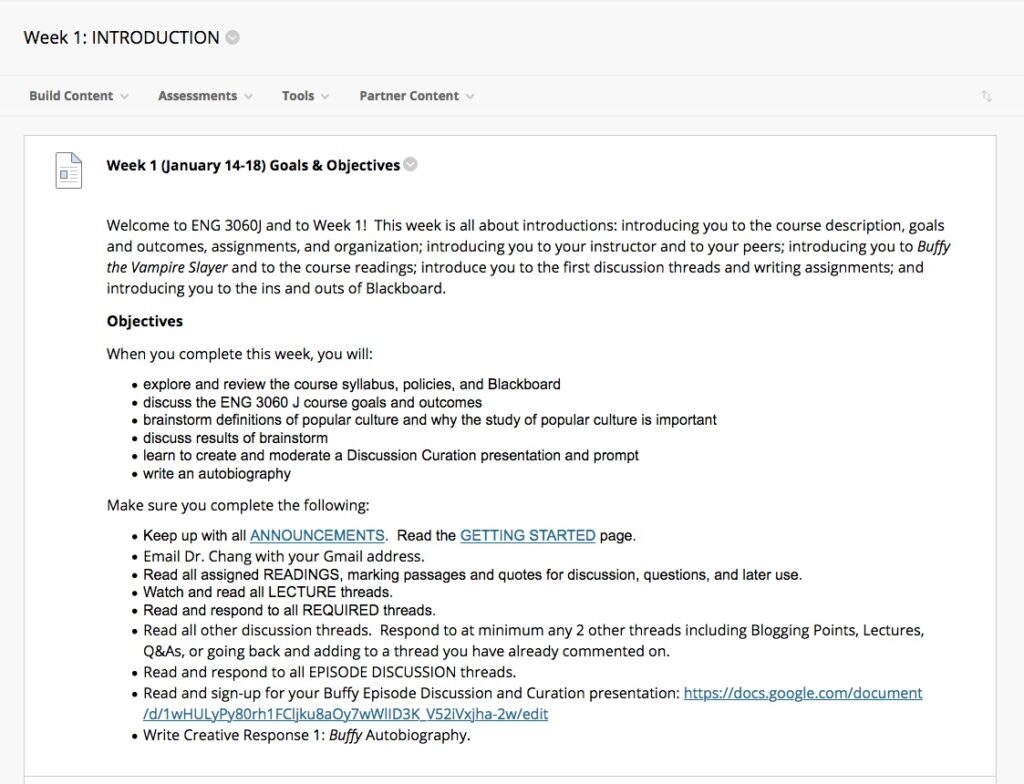
Here is the full week’s folder:
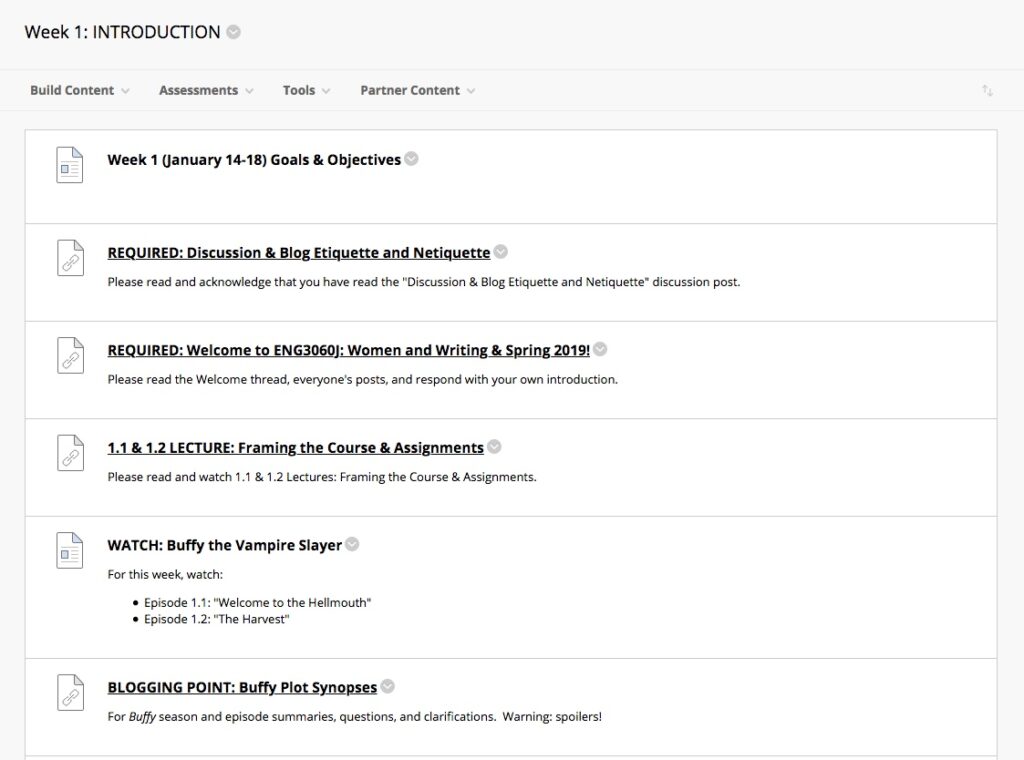
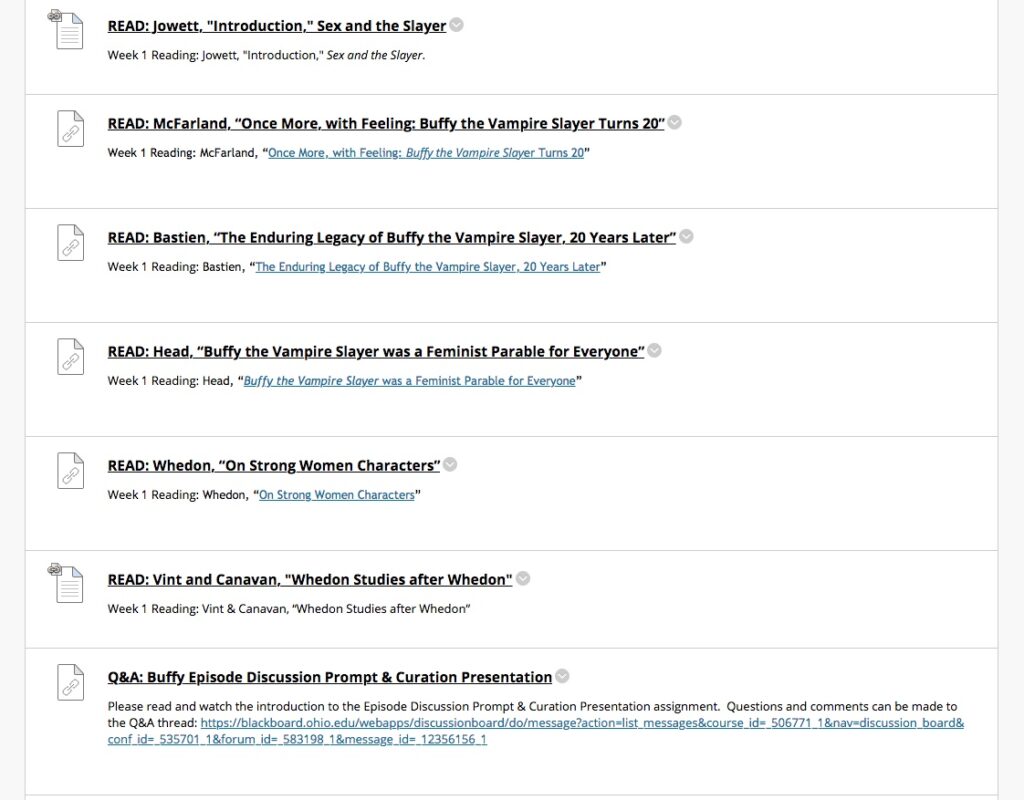
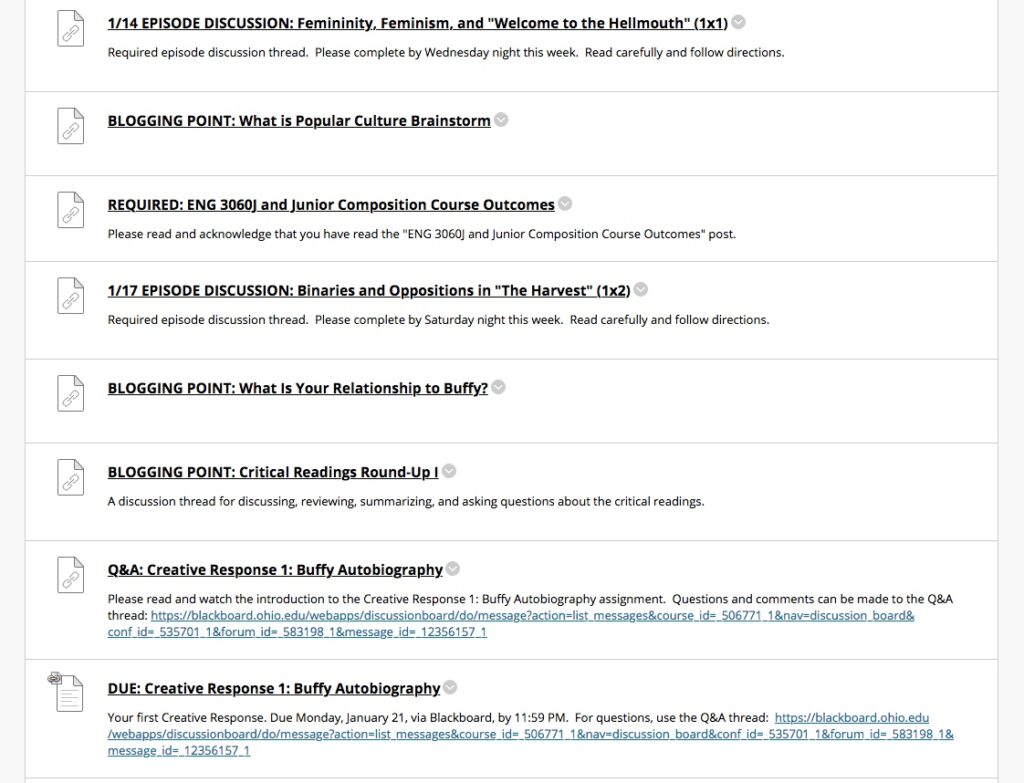
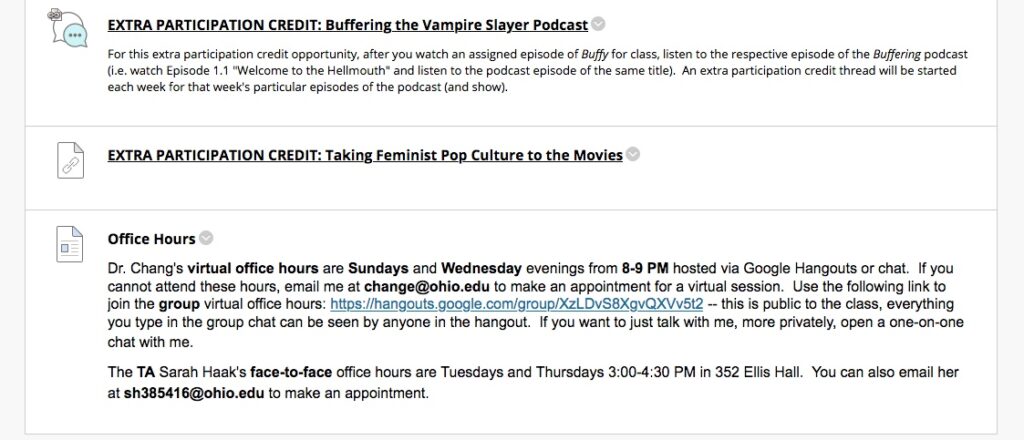
It is a lot. In the future, I am going to group certain things into blocks with embedded links rather than have them separate (like how the overview block works). For example, all of the Readings will be in one text block with direct links; this way it well cut down on white space, which reduces the amount of scroll needed to look for items. Certain items might be worth keeping separate, isolated as its own item, because it makes them easily copyable or includable to subsequent weeks).
A Sample Lecture
Given that ENG 3060J is designed to be asynchronous, I wanted to make sure I offered different ways, mediums, and personal touches to try to give the illusion of a face-to-face class. I like to record short videos, again no more than ten or so minutes, along with a write up that outlines what was covered by the video. There are a myriad of reasons why instructors (and students) are hesitant about posting video and/or audio because of privacy, control over recordings, gendered/racial/ableist bias, broadband access, and so on. However, if possible, I do think opening the information channels to multimodal communication does enrich the experience for all participants while taking care to remind students about respect, professionalism, and consent regarding one’s image, voice, and intellectual property (i.e. these are for class and educational purposes only, do not save or share without permission and/or attribution). Videos are done on my computer (in this case my mac’s photo booth), in one take (sometimes I have to practice a little), are unedited, and I use a innocuous filter to “soften” what I look like.
Here is a Lecture thread from week one, which I use to introduce the big questions and lines of inquiry of the course and how to engage in learning online:
1.1 LECTURE: Framing the Course
Periodically, I will post short video logs, vignettes, “lecturettes,” or whatever you want to call them. First, they let you see a real “live” person who is professing as professor to the class. Second, they are meant to be explanatory, clarifying, and hopefully, interesting–connected to material that you have been reading and watching. View them as soon as they are posted and return to them for reminders and clarifications. Respond or ask questions as needed.
According to the course syllabus and description:
WHEN JOSS WHEDON’S Buffy the Vampire Slayer television show debuted in 1997, no one could have foreseen the cult following, spinoffs, cultural phenomenon, and critical and scholarly interest it would inspire. In fact, “Buffy Studies” is now an established field that draws on a range of disciplines and perspectives. As Rhonda V. Wilcox and David Lavery say in their introduction to Fighting the Forces: What’s at Stake in Buffy the Vampire Slayer (2002), “The many meanings of Buffy are reflected in [s]cholars from English, communications, women’s studies, sociology, religion, and other fields…[who] present their different perspectives, sometimes analyzing the series and lines in radically different fashion, from cultural studies to Jungian analysis, from problematizing to praise…their multiplicity reflects the polysemic variety of this rich text” (xxvi).
IN HONOR of more than two decades of Buffy, our class will take up some of these critical approaches including film and media studies, feminism, queer theory, cultural studies, and fandom studies. Our class will address the critical question “Why Buffy?” and how might Buffy help us think about the recent resurgence of the figure of the vampire, about the role of monsters, and about cultural anxieties over race, gender, sexuality, and bodies. Given that Whedon has been praised and criticized for his representations of women and characters of color, this class will explore and analyze the intersections of identities and embodiments in selected episodes, scholarship, and fan communities.
What does this mean for the nuts and bolts of the class? Basically, I want to frame the goals of the course broadly with these outcomes:
• We will write for specific purposes, audiences and situations. To that end, we will develop and demonstrate a familiarity with a range of texts, terms, and theories of the study of Buffy, television, and popular culture.
• We will read a variety of texts and genres. We will identify and articulate different ways to explore, close read, analyze, and critique literature, film, television, and popular culture.
• We will research a variety of academic databases using appropriate and effective strategies. We will explore of a range of research tools and resources, and we will find and evaluate sources appropriate to our reading, writing, and study.
• We will consider questions and intersections of race, gender, sexuality, ability, class, nation, culture, and power.
• We will use television and popular culture as vernacular theory to think, talk, write, and interrogate the world around us.
More specifically,
• What is feminist and cultural studies analysis? What is “critique”? How do we do feminist close readings of Buffy the Vampire Slayer?
• What does it mean to be both an academic and a fan? How can we both enjoy/love something and still be critical/analytical?
• How might we use popular culture to theorize the world around us? In other words, how might Buffy (or any other popular cultural production) be a kind of vernacular theory?
If you can walk away from the class with reasonable answers to the above provocations, then I think you are in good shape. Overall, Buffy is the occasion to think about things like gender, race, sexuality, class, ability, and other identities and formations; to engage critical ways of thinking about and analyzing and writing about television and other media; and to gain some familiarity with the scholarship on Buffy and popular culture more generally.
Overall, students respond positively to these “lecturettes.” The regularly respond during the course and on evaluations that the videos made them feel more connected to the class, to the material, and to me as their teacher. As I have said elsewhere, I do not think full-length lectures or discussions are the way to go–at least not for every single week–though some disciplines and content may lend themselves to such a format. In future courses, particularly literature courses, I hope to experiment a little more with videos that show and model close reading, discussing, and going through a short story, section of a novel, or a scholarly essay. It is also possible to have students convert the video to audio only (there are number of easy tools available online) allowing them to listen a la a podcast, particularly if they have low or intermittent access to broadband internet service.
Peer Review
Because ENG 3060J is a writing course, students are given multiple opportunities to work on a range of writing skills and genres including academic and creative assignments. Peer review, when it works well, allows students to experience other people’s writing, to practice their own revision and feedback skills, and to collaboratively help and encourage one another. However, given the logistics of teaching online, I wanted to offer peer review twice during the term using a platform most students are familiar with: Google Docs. Obviously, there is careful and concrete explication of the process, a short video explaining what needs to be done, and a test run to work out the kinks. Here is the framing post for peer review (part of which is adapted from my colleague Dr. Ryan Shepherd‘s peer review materials):
Q&A: Peer Review, Google Docs, Peer Review Test
Over the course of the semester, you will have three formal peer review opportunities organized around three writing assignments: Short Paper 2: Close Reading Of, Short Paper 4: Revision Of, and your Final Project/Paper. Peer review, at its best, allows you to see others’ work, to provide feedback to other writers, and to receive feedback from your peers in the hopes of improving the clarity, specificity, and quality of one another’s writing.
These peer review “sessions” will be done through Google Docs. For each opportunity, you will be assigned to a small, rotating group (of 3 or 4). I will add you to Google Drive folders shared only with your group. On the due date for your draft (usually a Monday), you will be responsible for uploading your draft (preferably in Word format) to your assigned folder. Then your group will have the week (till Friday) to comment on one another’s work. I will be able to see everyone’s efforts and comments and will contribute feedback as needed. Once peer review is done, each writer will have the weekend to finalize their drafts taking into account everyone’s comments.
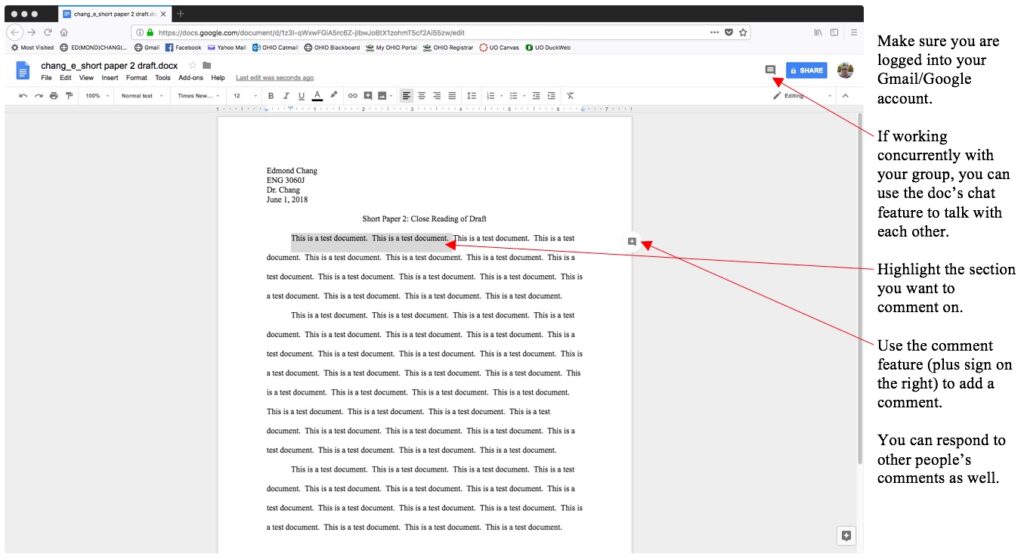
Here are the guidelines for peer review (adapted from Dr. Ryan Shepherd’s peer review rules):
• ONLINE CONTEXT
Online peer review’s strengths are that it is asynchronous (though you could collectively agree to work simultaneously on a document using the chat feature to discuss as a group); it allows each group member to add their comments to a single draft; and it allows for the web-based sharing and organizing of documents.
However, peer review online is similar to and different from face-to-face peer review. Pay close attention to tone, length, and online etiquette in your feedback. Remember that there’s another person on the other end of all of your comments: be polite and try to phrase things in a way that’s constructive.
• COMMENT ONLY
The best peer review process focuses on substantive feedback, focusing on making sure the paper satisfies the assignment; on the strength of claim or purpose; on the clarity and relevance of evidence, analysis, and explication; and on overall organization and flow of ideas.
Do not change or rewrite anything in your peers’ papers. You should only use the comment feature in Google Docs to offer feedback, ask clarifying questions, or to make suggestions.
You are not a proofreader. Do not make any comments on grammar, spelling, or mechanics. Instead, focus exclusively on the content of the critique.
• WHAT, HOW, and WHY
Each comment should have three parts: Comments should do more than just say that you “liked” something or that something was “good” or that something was “awkward.” Avoid abstractions and banal responses: these do not offer the what, how, and why that makes feedback substantive and helpful.
WHAT: establish a clear reference: point out what you are referring to, either by selecting the text directly with your comment or by referring to it in the comment itself.
HOW: offer a brief, clear explanation: explain what you think should be changed, offering suggestions for how it should be changed.
WHY: end each comment with a justification: clearly articulate why you think these changes should be made.
• CONVERSATION
Peer review is not a one-way street to a single destination. The best peer review means communication back and forth, a conversation between writers and reviewers, over time.
All comments (including your peers’ comments and my own) will show up in the same document for everyone to see. You are encouraged to not only read the other comments but to reply to them! You may agree, disagree, or offer additional examples, suggestions, clarifications.
• DUE
Monday: drafts must be uploaded to the proper peer review folder by the assigned due date and time. Failure to complete and upload a draft will affect your paper’s final grade as well as Class Participation.
Peer review should be conducted over the whole week. Check in often. Do not wait till the last day to contribute feedback. I will be checking to see who does what when and how complete each person’s comments are.
Complete peer review by the end of the day Friday. Peer review counts significantly toward your overall Class Participation grade.
To prepare for peer review, please do the following to familiarize yourself with the process. I will set up a Google Drive folder called “Peer Review Test Folder” and add everyone (again with your Gmail address). Once you have access:
• Create a test Word document. Set it up like a formal paper. Include any test text. Save it using the filename convention of: your last name_first initial_assignment name draft.docx (i.e. see above, chang_e_short paper 2 draft.docx)
• Upload your document to the Peer Review Test Folder.
• Please note that the uploaded file will be a Microsoft document. Once uploaded, open your document as a Google Doc and save. It will then be saved as a Google Drive document (the icons are different). Delete the Microsoft document to avoid confusion.
• Open at least three other people’s documents and add a test comment.
Use this Q&A thread for any questions, comments, or concerns about peer review and using Google Docs.
As with any activity, for the most part, the engaged students will take to peer review and the online format in a dedicated way. As the peer review week progresses, I will drop into each draft to offer my feedback, usually responding to a peer’s comments, and to note who has done the exercise or not. At the end of the peer review period, I will often offer one last end comment to crystallize what others have said and to offer a path or two for improvement. For privacy reasons, nothing is graded on Google Docs.

Other Possibilities
I hope some of these examples give folks an idea of how I tried to solve the problems and concerns of teaching online. Nothing is seamless, and nothing is perfect. However, weighing effort in versus results out, I think what I have done is a good balance of detail, ease, creativity, content, and meeting course and academic goals. I think the above course is well-planned, well-designed, but there is no way to cover every contingency, problem, or circumstance (happy or not). I will keep adapting and trying different things, of course, and I am learning from my friends and colleagues and my students in their approaches, successes, and perhaps most pointedly, where they fail.
The ENG 3060J course website has links to other assignments like my group presentation assignment: “Buffy Episode Discussion Curation & Presentation” and various handouts. Thank you again for reading. Please feel free to adapt, include, extend (and please credit me and each other). I am happy to share and exchange other solutions and tricks of the trade!